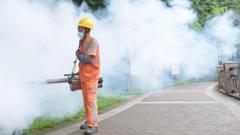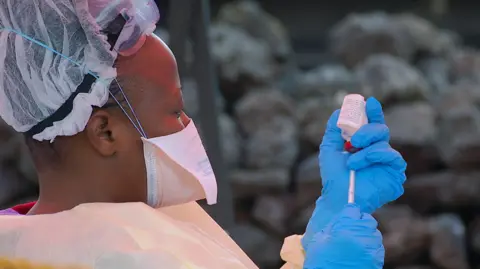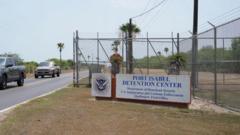The province has seen a surge of more than 7,000 chikungunya virus cases since July, prompting a response similar to strategies employed during the COVID-19 pandemic. Foshan city, particularly hard-hit, mandates hospitalization for chikungunya patients, providing mosquito nets for their beds. Patients can only be discharged upon testing negative or after a week, ensuring that the outbreak is contained.
Originating from mosquito bites, chikungunya manifests as fever and severe joint pain, which can persist for years. While outbreaks are prevalent in South and Southeast Asia as well as parts of Africa, they are relatively uncommon in China. Following an uptick in cases, including the first confirmed case in Hong Kong found in a traveling 12-year-old boy, public concern has intensified, with many expressing fears regarding the lingering effects of the virus on social media.
The U.S. has issued a travel advisory urging Americans to exercise caution when visiting China, as local authorities respond aggressively to clamp down on the outbreak. Measures include instructing residents to eliminate stagnant water to curb mosquito breeding, threatened fines of up to 10,000 yuan ($1,400) for non-compliance, and introducing "elephant mosquitoes" that prey on chikungunya carriers. Mosquito-eating fish have also been released into local lakes to assist in the effort.
While many neighboring cities had initially imposed a 14-day quarantine for travellers from Foshan, this measure has been rescinded amid a mix of public opinions. Comparisons between the current response and previous pandemic restrictions have sparked debate. Despite the majority of reported chikungunya cases being mild—95% of patients being discharged within a week—public anxiety remains high as authorities strive to educate residents about recognizing symptoms and seeking timely medical attention.
Understanding the virus is crucial; symptoms typically appear three to seven days post-bite and include rash, headache, swollen joints, alongside fever and pain. Although deaths from chikungunya are rare, those at risk for severe outcomes include newborns, the elderly, and individuals with preexisting health conditions. Identified first in Tanzania in 1952, the chikungunya virus has spread worldwide, with significant attention needed to prevent further localization of mosquito habitats as outlined by the World Health Organization.
Originating from mosquito bites, chikungunya manifests as fever and severe joint pain, which can persist for years. While outbreaks are prevalent in South and Southeast Asia as well as parts of Africa, they are relatively uncommon in China. Following an uptick in cases, including the first confirmed case in Hong Kong found in a traveling 12-year-old boy, public concern has intensified, with many expressing fears regarding the lingering effects of the virus on social media.
The U.S. has issued a travel advisory urging Americans to exercise caution when visiting China, as local authorities respond aggressively to clamp down on the outbreak. Measures include instructing residents to eliminate stagnant water to curb mosquito breeding, threatened fines of up to 10,000 yuan ($1,400) for non-compliance, and introducing "elephant mosquitoes" that prey on chikungunya carriers. Mosquito-eating fish have also been released into local lakes to assist in the effort.
While many neighboring cities had initially imposed a 14-day quarantine for travellers from Foshan, this measure has been rescinded amid a mix of public opinions. Comparisons between the current response and previous pandemic restrictions have sparked debate. Despite the majority of reported chikungunya cases being mild—95% of patients being discharged within a week—public anxiety remains high as authorities strive to educate residents about recognizing symptoms and seeking timely medical attention.
Understanding the virus is crucial; symptoms typically appear three to seven days post-bite and include rash, headache, swollen joints, alongside fever and pain. Although deaths from chikungunya are rare, those at risk for severe outcomes include newborns, the elderly, and individuals with preexisting health conditions. Identified first in Tanzania in 1952, the chikungunya virus has spread worldwide, with significant attention needed to prevent further localization of mosquito habitats as outlined by the World Health Organization.






















